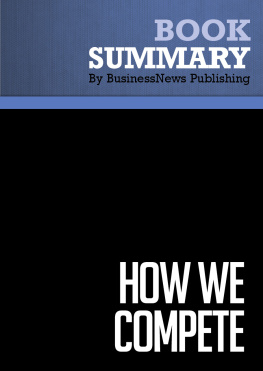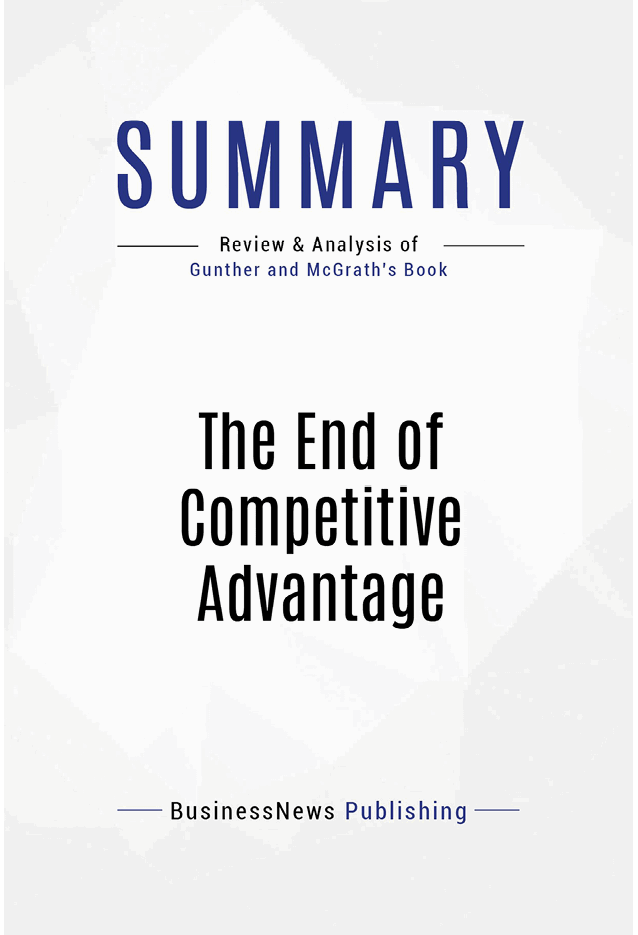Book Presentation
The End of Competitive Advantage by Rita Gunther McGRATH
Book Abstract
MAIN IDEA
All strategic frameworks and strategy textbooks produced to date have had one overarching aim: To build and then protect a sustainable competitive advantage against all challengers. A sustainable competitive advantage is the Holy Grail of traditional business strategy.
Competitive Advantage
In todays dynamic and ever-changing marketplace, however, sticking to the same old playbook and defending your competitive advantage is less helpful. Within a year, the marketplace can change dramatically. It doesnt seem smart to keep defending a competitive advantage which no longer matches the market,

Therefore, a better way to think about business strategy today is to figure out ways to build and then exploit successive transient advantages. You undertake new strategic initiatives, exploit any transient advantages which result for as long as possible and then move on to the next big thing.
Rather than trying to make your competitive advantage sustainable, plan your strategy around having multiple transient competitive advantages in play at the same time. If you can make your business strategy more fluid, more customer-centric and far less industry-bound, you will position your business to succeed.
Sustainable competitive advantage is now the exception, not the rule. Transient advantage is the new normal. Stability, not change, is the state that is most dangerous in highly dynamic competitive environments.
Rita McGarth
About the Author
RITA GUNTHER McGRATH is a professor at Columbia Business School. She is widely recognized as an expert on business strategy in volatile environments. She also consults with leading companies including Coca-Cola Enterprises, General Electric, Pearson and the World Economic Forum. Dr. McGrath is the author of three books including Discovery-Driven Growth and MarketBusters . Prior to joining the faculty of Columbia Business School, she served as an information technology director, worked in the political arena and founded two startups. She is a graduate of the Wharton School, University of Pennsylvania, Barnard College and the Columbia School of International and Public Affairs.
The Web site for this book is at www.ritamcgrath.com .
Important Note About This Ebook
This is a summary and not a critique or a review of the book. It does not offer judgment or opinion on the content of the book. This summary may not be organized chapter-wise but is an overview of the main ideas, viewpoints and arguments from the book as a whole. This means that the organization of this summary is not a representation of the book.
Summary of The End of Competitive Advantage (Rita Gunther McGrath)
1. The downside of competitive advantage
Having systems and structures which are focused on extracting maximum value from a competitive advantage become a liability when you have to change to exploit short-lived opportunities. To compete in todays dynamic marketplace, act differently.

The ultimate aim of most strategy playbooks has always been to build a sustainable competitive advantage and then defend it against all-comers. That may have been sound advice in past eras but when operating in a fluid and dynamic environment like today, competitive advantages dont last all that long. If youve invested all your assets in extracting maximum value from a competitive advantage and that advantage subsequently dissipates, then youre going to have problems.
Leaders have inherited a lot of ideas that may have made sense at one point but arent keeping up with the pace of strategic change today. Although executives realize that rapid change is the norm, the strategies they use to compete still draw on frameworks and practices that were most effective decades ago. Executives need a new set of strategy frameworks and practices for winning over the long haul, even as sustainable competitive advantages have become a thing of the past.
Rita McGrath
Conventional views of competitive advantage have always been based on two foundational assumptions:
- Industry matters most and you can get some decent payoffs by spotting industry trends and positioning yourself accordingly.
- Once achieved, a competitive advantage is sustainable and will endure due to the fact the industry dynamics are slow changing and wont vary much from one year to the next.
Those two assumptions can be fatal in the highly variable and dynamic competitive environments which exist today. These assumptions encourage inertia and building along the lines of existing business models rather than doing anything radical or different. It also means customers will end up seeking other alternatives which are a better match for their evolving needs and moving on. If youre not careful, you can end up becoming trapped in a competitive advantage while your market relevance slips away.

A far better way to operate today is to try and achieve some transient advantage which you exploit for as long as possible. Then, rather than trying to defend that advantage, you then move to another temporary advantage to match the shift in the marketplace. Instead of making one competitive advantage your fortress, you have the mindset that any advantage you do have is only temporary and therefore you should make hay while the sun is shining and then move on.
This approach of focusing on short-term advantages which are exploited for as long as feasible and then superseded by an updated and improved temporary advantage makes sense when the marketplace is changing and evolving rapidly. When you rely on transient advantages, youre not making a bet there will be no changes which end up invalidating your original competitive advantage. Youre not saying you expect the marketplace to be static and for the existing dynamics to hold true forever and a day.
Some companies are already doing this to great effect. A good example is Infosys which goes through a top-to-bottom company reorganization every two to three years. By doing this, Infosys breaks up the inertia which any company builds up over time. Infosys also uses these reorganizations as an opportunity to move people and resources out of projects which are losing steam and into the emerging-growth opportunities of the future.
The cost of reorganizing the company is nothing compared to the growth potential it unleashes. We work out what our new axis of growth will be, then reorganize the company to deliver to these axes.
Sanjay Purohit, head of planning, Infosys
The strategy playbook today needs to be based on the idea of transient competitive advantage that is, where you compete, how you compete, and how you win is very different when competitive advantage is no longer sustainable.








